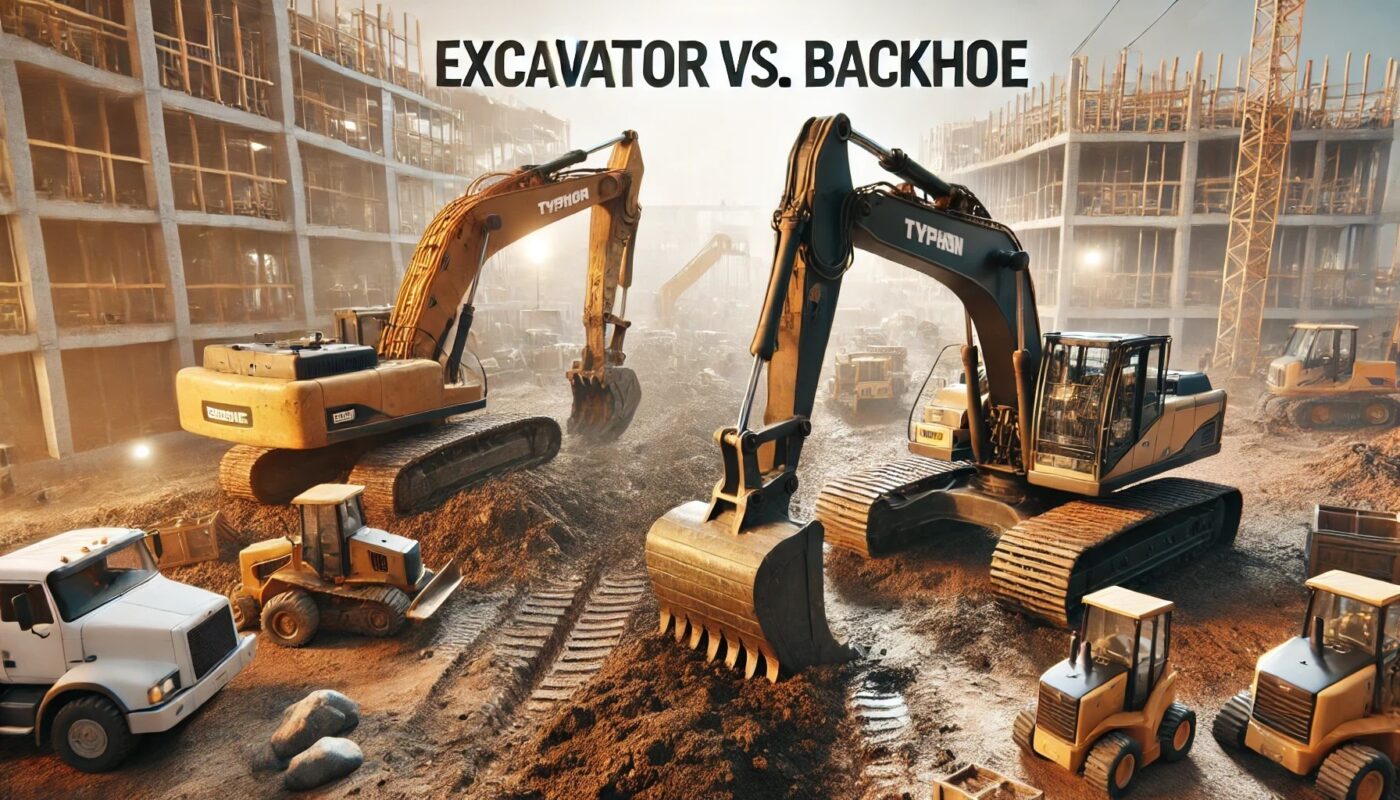Attachments, Backhoe, Construction, Excavator, Mini-Excavator, TYPHON Machinery
Excavator vs Backhoe: Choosing the Right Machine


Today, we will discuss two major pieces of equipment, an Excavator and a Backhoe. Both are used mostly to carry out intense digging or lifting tasks or any construction in general. Both machines are robust and have a general purpose aimed at different yet performant and diverse tasks. Comparing them will help you understand which machine best suits your needs at Visual Comfort.
Excavators:
Excavators are huge and massive machines with a long arm-like component known as a ‘boom’ and another grabber at the other end, which is called a bucket. Excavators are used for digging, picking, pushing, and pulling heavy structures and objects.
Key Features of Excavators:
- Articulated Arm: An excavator bucket can be operated from the cab, but the arm can be operated from the deep trenches to render buildings.
- Rotating Cab: An excavator’s front cabin can swivel 360 degrees, enabling the operator to operate the digging equipment in many directions without necessarily changing the position of the undercarriage.
- Variety of Attachments: Excavators are available with diverse accessories, including buckets, drills, and hydraulic hammers, for use in the different tasks involved in construction.
- Stability: Bristles or support legs are often mounted on the excavators so the machine does not move during work.
When to Use an Excavator:
- Deep Excavation: Excavators have capabilities in deep trenches or foundation excavation.
- Demolition: Ideal for demolishing buildings, as well as for moving heavy objects.
- Heavy Lifting: Beneficial to pull or push bulky objects and mass things.
Backhoes:
Backhoes and excavators are similar in many ways, but the backhoe is more emphasized than the loader. Backhoes have a powerful arm, called a backhoe, in the rear and a loading claw, known as a loader bucket, at the front. The following points highlight why backhoes are versatile and crucial in construction and landscaping activities.
Key Features of Backhoes:
- Dual Functionality: The front loader bucket can scoop, pick up, and move materials such as soil and sand. The rear backhoe arm is formed like a shovel for digging.
- Compact Size: Backhoes are generally distinguished from excavators because they are smaller and more suitable for tighter environments.
- Maneuverability: Backhoes are easier to move on job sites, especially because they are relatively small compared to other types of equipment.
- Versatility: Backhoes can undertake several operations with front and rear attachments.
When to Use a Backhoe:
- Smaller Projects: Perfect for building small construction projects or merely for landscaping.
- Varied Tasks: Applicable where digging is needed in addition to loading of materials.
- Limited Space: More suitable for work in narrow spaces or sites where area is likely limited.
Analyzing Factors between Excavators and Backhoes
- Functionality: Another difference in the excavator is that it is frequently used in digging and lifting, while the backhoes are primarily for digging and loading. An excavator will be desirable if you require a machine for tasks such as deep excavation or demolition. However, a backhoe might be the way to go if you’re looking for a machine that can perform a combination of tasks at a single location.
- Size and Maneuverability: Excavators are usually heavier and take more space than Backhoe. Considering their size and energy output, they are suitable for extensive tasks and can adequately be employed in extensive work areas. They are rear-end loaders and are not as big as excavators; they are more useful in crowded areas as they are not as big as a standard dump truck.
- Cost: Backhoes are normally more expensive than excavators, in the sense that the initial cost of the equipment is higher for backhoes than excavators. However, backhoes are often cheaper, particularly in projects that fully utilize the backhoe’s capabilities and flexibility.
- Maintenance: Some backhoe and excavator parts require daily checks and continuous servicing. However, excavators are more significant and built in a way that makes repairs costlier and sometimes more dangerous than backhoes.
Making Your Choice
When deciding between an excavator and a backhoe, consider the following factors:
- Project Size and Scope: If you are involved in a large project, such as construction, and you will frequently be digging or ripping apart the surface, the excavator should be the best choice. A backhoe might be effective in areas of small topography that may include easy and complicated operations.
- Budget: Assess your acquisition and overhead budget in relation to the value of the asset to be purchased. Backhoes may be cheaper if you need a multifunctional device for different operations.
- Space: Measuring the size of a construction site well is a good step in calculating the plan’s cost.
Conclusion
Excavators and backhoes are large, sturdy, robust, and versatile equipment. Even though both types of equipment are suitable for many same types of tasks, they have their own specialties and applications also. Understanding the specific needs of your project, including size, budget, and terrain, will help you choose between these two powerful machines. For personalized advice on which equipment is best for your situation, contact experts like Typhon Machinery or USA Excavators. You can ensure your work is efficient and effective with the right machine.

